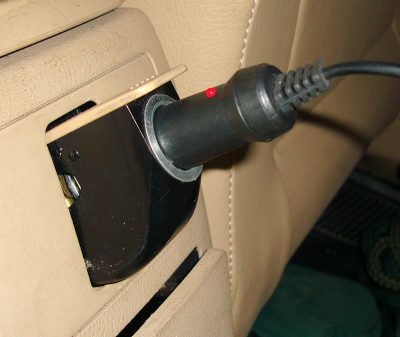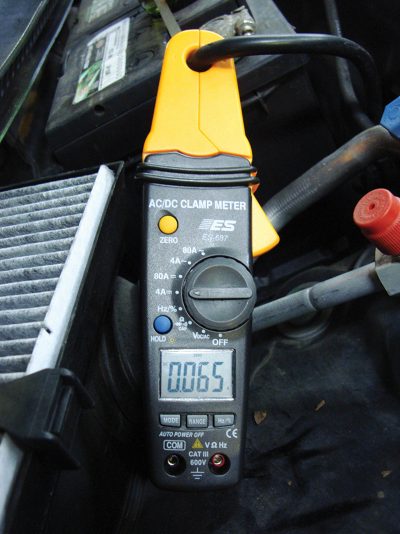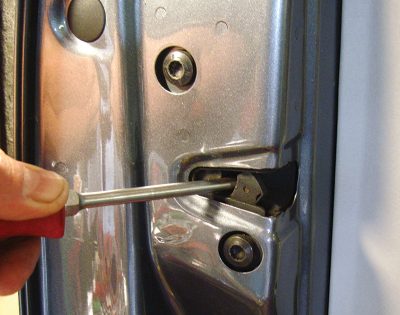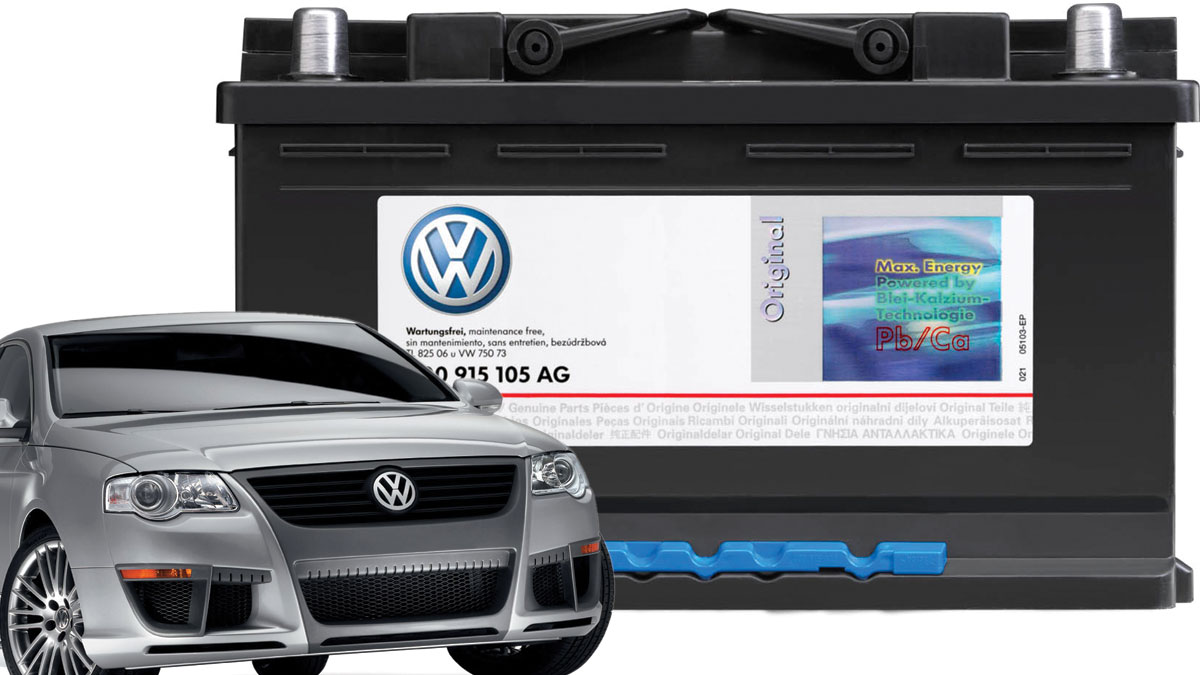These days, a dead battery caused by a key-off drain has become one of the more difficult problems to diagnose. It could be a simple switch or relay that’s stuck on, but what if it is computer-related? What if one control unit is staying awake? How are you going to troubleshoot this one?
Ask five automotive technicians how to isolate a battery drain and you’ll get six different answers! Everyone uses his or her own experience as a guide to solve a problem, and, in desperate situations, someone else’s. To state the obvious, the battery in a car is there to store electrical power. This energy stands by to be used when the driver turns on the ignition key. Then, there is voltage available to the starter, engine management system, and electrical accessories. This stored power is soon depleted if the charging system isn’t replacing it. This is why a battery becomes drained if the key is left on.
The length of time a battery can hold its charge depends on the ambient temperature, state of charge, and life cycle of the battery. If some component in the vehicle stays on while the key is shut off, the drain on the battery may be high enough to reduce the electrical power stored in the battery to the point where the vehicle can no longer be started.
So that there’s no confusion, let’s define a battery drain as excessive current flow even when the vehicle is shut off. Without the engine running, the alternator can’t recharge the battery. If excessive current is flowing with the ignition switch off, the battery will go dead after a short period of time. Unless you connect a battery charger overnight, the vehicle may not start the next day. This is known simply as “battery drain.†Some drains are high-current and will deplete the battery in only a few hours. Other drains are much smaller and may only cause a battery to go dead in a matter of days. In order to find the source of the problem, you need a logically-ordered testing procedure. Sure, it’s traditional to just put a test light or ammeter in series between a battery terminal and the cable clamp, then pull fuses and unplug components (stuck relay?) until the draw drops to nearly nothing, but there’s a lot more to consider today.
Amperage in series
There needs to be a method of measuring the drain, and another method for isolating the source. Of course, you have to measure the drain with the ignition key off, and remember that the doors have to be closed to keep the courtesy lights out. Since it is a drain on the electrical storage capacity of the battery, you need to measure amperage. Basic electrical classes should have taught you that voltage is electromotive force, the “pressure†of the electron flow, and that amperage is the amount or volume of electricity flowing. You also should have been taught that you can measure voltage in parallel, which means you simply have to ground your meter and probe for voltage with the other lead. When measuring amperage, you need to open the circuit and attach a measuring device in “series†— in other words, all the current consumed by the circuit must go through the meter. Be careful of the capacity of your tester here. A very large short (say, over 10 amps) could exceed its amperage capacity and blow its fuse, or even burn it out. It doesn’t matter whether you use the positive or negative battery post, just hook up your leads in series following the direction of current flow and the polarity of your meter.

No more test lights
Measuring amperage in older cars is fairly simple. You were probably taught to use a test light and see if it was lit. Since these cars had little in the way of electronics aboard, there should not be any appreciable current flow with the key off, at least not enough to turn on a test light. Now we have many computers on vehicles, and they may “wake up†by simply pulling on a door handle. Body control modules start communicating with one another, and they may also communicate with the powertrain CAN. With the new 2.0L TFSI® engines, the fuel pump is run once the door handle is pulled in order to prime the fuel injection system, which amounts to another considerable draw.
For a control unit to be prepared to look for switch inputs with the ignition key off, it needs to have some electrical power all of the time. Some accessories are kept on even after the ignition key has been shut off. This full-time voltage supply would quickly drain a battery, so the engineers gave these control units a “sleep†mode. While the unit is asleep, the electrical draw is brought down to an acceptable minimum that a battery can handle for a few weeks.

The relatively small amount of current needed to supply power to sleeping control units is often enough to make some test lights glow, especially the LED type. Therefore, this is no longer a valid test for a battery drain. You should connect a Volkswagen approved meter in series and set it to amperage so you can accurately measure the drain. The problem is that when you disconnect the battery, you may shut off the existing drain and therefore eliminate the problem you are trying to diagnose (it will almost surely come back). Also, when you reconnect the battery all the control units are going to wake up at the same time. You will then see an abnormally high amperage draw on the battery. You will have to wait for the control units to go back to sleep again to get a normal reading.
When it comes to measuring drains, there are some new tools out there that can make your life easier, but you should always back up your measurements with a Volkswagen approved DMM. Low-current inductive amp probes have been around for many years. They allow you to clip around a large-gauge wire and measure current flow without opening the circuit. This helps you avoid changing the conditions of the draw and skewing your findings.
You don’t have to break the circuit

Now for practical procedures. It’s not necessary to open the circuit completely when removing the battery cable clamp. When using the negative battery post, simply connect your ammeter’s negative lead to the post, then the positive lead to the battery cable. Slowly lift the negative battery cable off the post being careful not to knock your test lead clamps off. This way, the current flow is never interrupted. You can measure the amperage draw with an inductive clamp on your meter, but you will have to get to the battery first. In the case of a 2004 Passat, for example, you are going to have to open the hood, and in order to do that you have to open the door. Once you pull on the handle, the door module is going to see the switch input change. It will then wake up the CAN and transmit the message to the central locking control unit. Now that the CAN is awake, all of the control units on that CAN will wake up and start drawing more current.

You will have to wait for the CAN to go back to sleep to get an accurate amp draw measurement. This may not be possible if you need to keep the door open to access fuse and relay panels. The door module will see the switch status and never allow the CAN to sleep. What can you do? You’ll need to “fool†the control units into thinking the doors are closed. You can do this by “tripping†the latches in the doors and trunk while they are open. On most contemporary Volkswagen models, the power door lock actuator, door handle, and door closed switch are all built into the latch. They send signals to the control module for that door. These signals are then sent to the central locking/convenience module. Locking the latches makes the control units think that all the doors are closed and will allow the CAN to go to sleep. Of course, pulling on the door handle again will still wake up the system so don’t do that. You can use an oscilloscope to monitor the CAN signals and see when they stop transmitting data. Now you now know the CAN is asleep. At this point you should have your lowest amp draw from the body control system.
Rules of thumb
Since control units absorb some current while the key is off, you should get a small reading. Under 50mA (milliamps) is an acceptable amount of current draw. If you see 100mA, expect that the battery will drain down in a few days. Upwards of 500mA and the battery may die that day. If it is easier for you to think of the draw in terms of amps, then 100mA is .1 of an ampere. If you see 0.50 amps, you know the vehicle is drawing 500mA. Simply move the decimal point three places to the right when converting amps to milliamps, or three places to the left to convert from milliamps to amps. A reading of 50mA converts to under 0.05 amps.
With those basic specs in mind and with the modules in sleep mode, you can check for a draw that may discharge the battery. If you read over 50mA, you are going to have to start isolating the source of the drain. The only way you can do this is by opening each circuit one at a time until the drain goes away.
Since you do not know the source of the draw, you have to unplug every electrical consumer on the vehicle. Unplug each fuse one at a time and check your amp draw measurement. You should see it drop to acceptable levels when you have unplugged the power supply of the problem component. Always keep in mind that a normal draw is just below 50mA. You do not want to see the amp reading going below that since you may have taken away the key-off power supply to modules that need it to function. Another minor problem is the waking up of the CAN. If you unplug the fuse that supplies constant battery voltage (terminal 30) and plug it back in, it will wake up the CAN it is connected to and many control units will start drawing current. When removing and installing these fuses, you are going to have to wait again for the CAN to go into sleep mode.
Diagrams save time

If you do unplug the source of the draw and measure below 50mA, you can now look at a wiring diagram and unplug only the components that are powered by that fuse. This is much easier and less time-consuming than randomly unplugging components you suspect are the problem. Evaluating a wiring diagram before you start unplugging fuses should give you a plan for which fuses to pull and how to proceed. Obviously, only focus on fuses and relays that have constant power. They will be identified as circuit #30 in the wiring diagram. In the Deutsches Industrie Norm (DIN) Volkswagen wiring diagrams, circuit #30 indicates a constant 12V supply. Terminals with the number 15 will have power only with the ignition on, and that is not when you are having your problem.
Another possible source of the trouble is the battery itself. It should be tested and, if it is found to be weak, be replaced with an OEM Volkswagen battery as aftermarket units may not meet Volkswagen specifications for reserve capacity. Most American aftermarket batteries use Cold Cranking Amps (CCA) as a benchmark for comparison, whereas most European vehicles require batteries with higher reserve capacity. Reserve capacity is a measurement of how long the charge will last in minutes with a specific load applied. Vehicles with CAN systems need higher reserve capacity to maintain system voltage when the CAN is asleep. You can help ensure that you meet these requirements with replacement batteries from your Volkswagen dealer. This final tip will give you the peace of mind of knowing that you have done the best you can for your customers, and who wouldn’t want that?
Download PDF




0 Comments